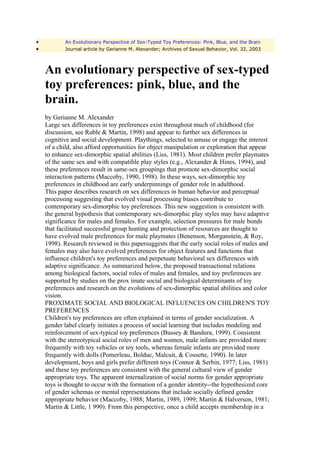
Evolutionary Perspective of Sex-Typed Toy Preferences and Brain Development
- 1. • An Evolutionary Perspective of Sex-Typed Toy Preferences: Pink, Blue, and the Brain • Journal article by Gerianne M. Alexander; Archives of Sexual Behavior, Vol. 32, 2003 An evolutionary perspective of sex-typed toy preferences: pink, blue, and the brain. by Gerianne M. Alexander Large sex differences in toy preferences exist throughout much of childhood (for discussion, see Ruble & Martin, 1998) and appear to further sex differences in cognitive and social development. Playthings, selected to amuse or engage the interest of a child, also afford opportunities for object manipulation or exploration that appear to enhance sex-dimorphic spatial abilities (Liss, 1981). Most children prefer playmates of the same sex and with compatible play styles (e.g., Alexander & Hines, 1994), and these preferences result in same-sex groupings that promote sex-dimorphic social interaction patterns (Maccoby, 1990, 1998). In these ways, sex-dimorphic toy preferences in childhood are early underpinnings of gender role in adulthood. This paper describes research on sex differences in human behavior and perceptual processing suggesting that evolved visual processing biases contribute to contemporary sex-dimorphic toy preferences. This new suggestion is consistent with the general hypothesis that contemporary sex-dimorphic play styles may have adaptive significance for males and females. For example, selection pressures for male bonds that facilitated successful group hunting and protection of resources are thought to have evolved male preferences for male playmates (Benenson, Morganstein, & Roy, 1998). Research reviewed in this papersuggests that the early social roles of males and females may also have evolved preferences for object features and functions that influence children's toy preferences and perpetuate behavioral sex differences with adaptive significance. As summarized below, the proposed transactional relations among biological factors, social roles of males and females, and toy preferences are supported by studies on the prox imate social and biological determinants of toy preferences and research on the evolutions of sex-dimorphic spatial abilities and color vision. PROXIMATE SOCIAL AND BIOLOGICAL INFLUENCES ON CHILDREN'S TOY PREFERENCES Children's toy preferences are often explained in terms of gender socialization. A gender label clearly initiates a process of social learning that includes modeling and reinforcement of sex-typical toy preferences (Bussey & Bandura, 1999). Consistent with the stereotypical social roles of men and women, male infants are provided more frequently with toy vehicles or toy tools, whereas female infants are provided more frequently with dolls (Pomerleau, Bolduc, Malcuit, & Cossette, 1990). In later development, boys and girls prefer different toys (Connor & Serbin, 1977; Liss, 1981) and these toy preferences are consistent with the general cultural view of gender appropriate toys. The apparent internalization of social norms for gender appropriate toys is thought to occur with the formation of a gender identity--the hypothesized core of gender schemas or mental representations that include socially defined gender appropriate behavior (Maccoby, 1988; Martin, 1989, 1999; Martin & Halverson, 1981; Martin & Little, 1 990). From this perspective, once a child accepts membership in a
